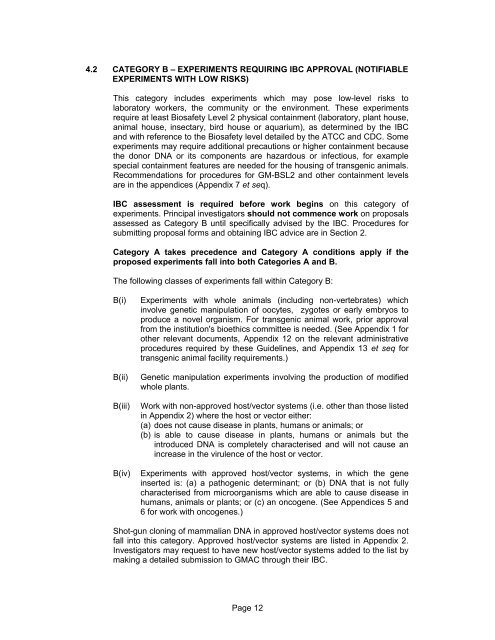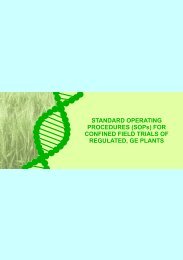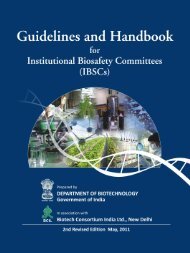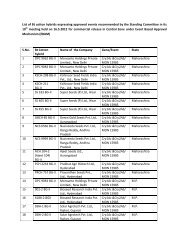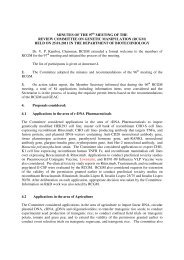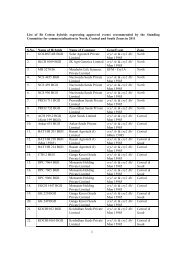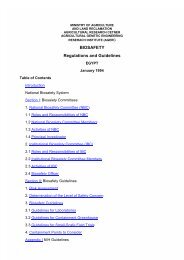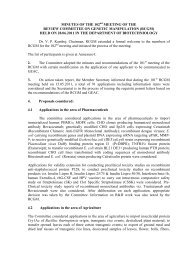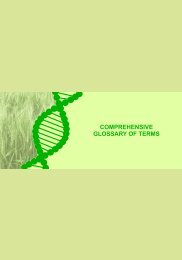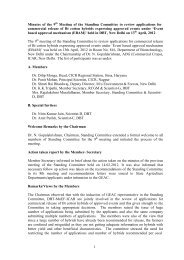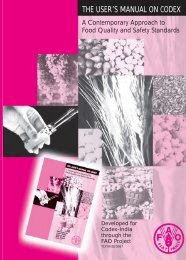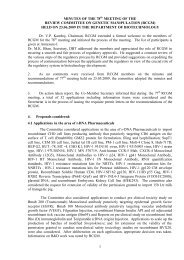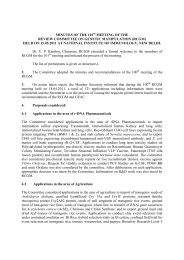Biosafety Guidelines For Research On Genetically Modified ...
Biosafety Guidelines For Research On Genetically Modified ...
Biosafety Guidelines For Research On Genetically Modified ...
You also want an ePaper? Increase the reach of your titles
YUMPU automatically turns print PDFs into web optimized ePapers that Google loves.
4.2 CATEGORY B – EXPERIMENTS REQUIRING IBC APPROVAL (NOTIFIABLE<br />
EXPERIMENTS WITH LOW RISKS)<br />
This category includes experiments which may pose low-level risks to<br />
laboratory workers, the community or the environment. These experiments<br />
require at least <strong>Biosafety</strong> Level 2 physical containment (laboratory, plant house,<br />
animal house, insectary, bird house or aquarium), as determined by the IBC<br />
and with reference to the <strong>Biosafety</strong> level detailed by the ATCC and CDC. Some<br />
experiments may require additional precautions or higher containment because<br />
the donor DNA or its components are hazardous or infectious, for example<br />
special containment features are needed for the housing of transgenic animals.<br />
Recommendations for procedures for GM-BSL2 and other containment levels<br />
are in the appendices (Appendix 7 et seq).<br />
IBC assessment is required before work begins on this category of<br />
experiments. Principal investigators should not commence work on proposals<br />
assessed as Category B until specifically advised by the IBC. Procedures for<br />
submitting proposal forms and obtaining IBC advice are in Section 2.<br />
Category A takes precedence and Category A conditions apply if the<br />
proposed experiments fall into both Categories A and B.<br />
The following classes of experiments fall within Category B:<br />
B(i)<br />
B(ii)<br />
B(iii)<br />
Experiments with whole animals (including non-vertebrates) which<br />
involve genetic manipulation of oocytes, zygotes or early embryos to<br />
produce a novel organism. <strong>For</strong> transgenic animal work, prior approval<br />
from the institution's bioethics committee is needed. (See Appendix 1 for<br />
other relevant documents, Appendix 12 on the relevant administrative<br />
procedures required by these <strong>Guidelines</strong>, and Appendix 13 et seq for<br />
transgenic animal facility requirements.)<br />
Genetic manipulation experiments involving the production of modified<br />
whole plants.<br />
Work with non-approved host/vector systems (i.e. other than those listed<br />
in Appendix 2) where the host or vector either:<br />
(a) does not cause disease in plants, humans or animals; or<br />
(b) is able to cause disease in plants, humans or animals but the<br />
introduced DNA is completely characterised and will not cause an<br />
increase in the virulence of the host or vector.<br />
B(iv) Experiments with approved host/vector systems, in which the gene<br />
inserted is: (a) a pathogenic determinant; or (b) DNA that is not fully<br />
characterised from microorganisms which are able to cause disease in<br />
humans, animals or plants; or (c) an oncogene. (See Appendices 5 and<br />
6 for work with oncogenes.)<br />
Shot-gun cloning of mammalian DNA in approved host/vector systems does not<br />
fall into this category. Approved host/vector systems are listed in Appendix 2.<br />
Investigators may request to have new host/vector systems added to the list by<br />
making a detailed submission to GMAC through their IBC.<br />
Page 12


